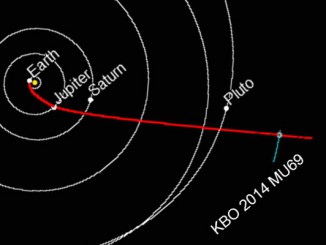
Credits: NASA/JHUAPL/SWRI
Geologists said Thursday they are bewildered by images from NASA’s New Horizons spacecraft baring unseen landscapes on Pluto with unexpected “snakeskin” textures, colourful chasms routing through ancient landforms, and vivid new views of apparent glacial flows.
One close-up of a set of aligned ridges near Pluto’s day-night terminator, which was at sunset when New Horizons encountered Pluto, has scientists puzzled.
“It’s a unique and perplexing landscape stretching over hundreds of miles,” said William McKinnon, New Horizons’ geology, geophysics and imaging team deputy lead from Washington University in St. Louis. “It looks more like tree bark or dragon scales than geology. This’ll really take time to figure out; maybe it’s some combination of internal tectonic forces and ice sublimation driven by Pluto’s faint sunlight.”
The latest images released Thursday add high-resolution colour to the black and white pictures previously downlinked from New Horizons, which swept past Pluto on July 14 to give humans their first up close views of the faraway world.
Scientists used data from a the MVIC colour camera inside the probe’s Ralph instrument to create a global view of Pluto. Information collected through the camera’s blue, red and infrared filters show variations in Pluto’s complex terrains, and scrolling across the 6.4 million pixel image reveals countless distinct features — craters, channels and vast ice fields — each with their own convoluted history.
“This image consumed the better part of this week for me,” tweeted Alex Parker, a planetary scientist at the Southwest Research Institute. “I removed striping noise and deconvolved the images, massively improving sharpness.”

The colours are stretched and do not represent what the human eye would see, but scientists say they are useful to bring out different types of terrain dotting Pluto.
“We used MVIC’s infrared channel to extend our spectral view of Pluto,” said John Spencer, a geology, geophysics and imaging team deputy lead from SWRI in Boulder, Colorado. “Pluto’s surface colours were enhanced in this view to reveal subtle details in a rainbow of pale blues, yellows, oranges, and deep reds. Many landforms have their own distinct colours, telling a wonderfully complex geological and climatological story that we have only just begun to decode.”
Scientists likened the Pluto’s spectacular colours to a “red velvet cupcake with cream cheese frosting.”
You can view the nearly 70-megabyte image in full resolution on NASA’s website.
“Click that link,” Parker posted to his Twitter account. “Zoom in. This image is unlike anything you have ever seen.”
Just how big is that new enhanced-colour picture of Pluto? Here’s a rough comparison to the iPhone 6 camera sensor: pic.twitter.com/zuDSZVcrZF
— Alex Parker (@Alex_Parker) September 24, 2015
NASA also released the sharpest views yet of Pluto from New Horizons’ telescopic LORRI camera, which takes pictures in black and white.
“These images — the highest-resolution yet available of Pluto — reveal features that resemble dunes, the older shoreline of a shrinking glacial ice lake, and fractured, angular water ice mountains with sheer cliffs,” NASA said in a press release. “Colour details have been added using MVIC’s global map shown above.”

Parker said combining data from the black and white LORRI imager and MVIC colour camera was painstaking because the images were taken from different orientations.
“This means going in by hand, determining the size, shape, height, and features of each mountain, and stretching and warping them to match,” he said on Twitter. “My eyes hurt, but I think the result paid off.”
Scientists said the closer look at Sputnik Planum, a giant ice field the size of Texas, shows it is covered in previously unresolved pits and bumpy terrain. The textures could be dunes of ice particles.
Newly-downlinked data from New Horizons may have moved scientists closer to answering what makes up the icy plains of Sputnik Planum, which makes up the western lobe of a bright heart-shaped feature spotted by the probe on approach to Pluto.
An infrared spectrometer aboard New Horizons mapped concentrations of methane on the dwarf planet, and the results show an uneven distribution. Sputnik Planum appears to be rich in methane, while darker, older material to the southwest in an area informally named Cthulhu Regio has relatively little methane.
Matching the methane data with the global map of Pluto shows more methane in regions appearing brighter in colour imagery, but scientists are not sure how the results are correlated.
“It’s like the classic chicken-or-egg problem,” said Will Grundy, New Horizons surface composition team lead from Lowell Observatory in Flagstaff, Arizona. “We’re unsure why this is so, but the cool thing is that New Horizons has the ability to make exquisite compositional maps across the surface of Pluto, and that’ll be crucial to resolving how enigmatic Pluto works.”
Researchers expect all of the Pluto flyby data to be on the ground in late 2016 — a limitation imposed by the spacecraft’s 3 billion mile distance from Earth. Only then will the New Horizons science team begin to fully piece together how the distant world’s climate and geology interact.
Scientists will attempt to learn how Pluto changes with its 6.4-day rotation and decades-long seasons as the dwarf planet circuits the sun every 248 years.
“With these just-downlinked images and maps, we’ve turned a new page in the study of Pluto beginning to reveal the planet at high resolution in both colour and composition,” said Alan Stern, New Horizons’ principal investigator from the Southwest Research Institute. “I wish Pluto’s discoverer Clyde Tombaugh had lived to see this day.”
Email the author.
Follow Stephen Clark on Twitter: @StephenClark1.



